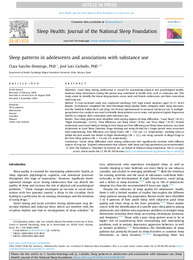Por favor, use este identificador para citar o enlazar este ítem:
https://hdl.handle.net/11000/33990Registro completo de metadatos
| Campo DC | Valor | Lengua/Idioma |
|---|---|---|
| dc.contributor.author | Sancho-Domingo, Clara | - |
| dc.contributor.author | Carballo, José Luis | - |
| dc.contributor.other | Departamentos de la UMH::Psicología de la Salud | es_ES |
| dc.date.accessioned | 2024-11-22T13:28:19Z | - |
| dc.date.available | 2024-11-22T13:28:19Z | - |
| dc.date.created | 2024-10-23 | - |
| dc.identifier.citation | Sleep Health: Journal of the National Sleep Foundation, 2024 | es_ES |
| dc.identifier.issn | 2352-7218 | - |
| dc.identifier.uri | https://hdl.handle.net/11000/33990 | - |
| dc.description.abstract | Objectives: Good sleep during adolescence is crucial for maintaining physical and psychological health; however, sleep disturbance during this period may contribute to health risks, such as substance use. This study aimed to identify the latent sleep patterns across male and female adolescents, and their association with drug use. Method: A cross-sectional study was conducted involving 1391 high school students (aged 15-17; 56.4% female). Participants completed the brief Pittsburgh Sleep Quality Index alongside other sleep measures, and the Timeline Follow-Back and Drug Use History Questionnaire to measure substance use. A multiplegroup latent class analysis was used to identify sleep patterns across sexes, and pairwise Logistic Regression models to compare their association with substance use. Results: Four sleep patterns were identified with varying degrees of sleep difficulties: "Good Sleep" (43.3%), "Night Awakenings" (31.8%), "Poor Efficiency and Sleep Onset" (9.4%), and "Poor Sleep" (15.5%). Female adolescents were more likely to belong to Poor Sleep and Poor Efficiency and Sleep Onset patterns, and male adolescents to Good Sleep. Likewise, binge drinking and using alcohol for a longer period were associated with experiencing Poor Efficiency and Sleep Onset (OR = 1.03 and 2.3, respectively); smoking tobacco within the past month was linked to Night Awakenings (OR = 2.2); and using cannabis or illegal drugs to the Poor Sleep pattern (OR = 2.4 and 2.6, respectively). Conclusions: Varied sleep difficulties exist among adolescents that significantly correlate with different aspects of drug use. Targeted interventions that address both sleep and drug prevention are recommended | es_ES |
| dc.format | application/pdf | es_ES |
| dc.format.extent | 8 | es_ES |
| dc.language.iso | eng | es_ES |
| dc.publisher | Elsevier | es_ES |
| dc.rights | info:eu-repo/semantics/openAccess | es_ES |
| dc.rights | Attribution-NonCommercial-NoDerivatives 4.0 Internacional | * |
| dc.rights.uri | http://creativecommons.org/licenses/by-nc-nd/4.0/ | * |
| dc.subject | Sleep patterns | es_ES |
| dc.subject | Adolescents | es_ES |
| dc.subject | Alcohol | es_ES |
| dc.subject | Cannabis | es_ES |
| dc.subject | Tobacco | es_ES |
| dc.subject | Latent class analysis | es_ES |
| dc.subject.other | CDU::1 - Filosofía y psicología::159.9 - Psicología | es_ES |
| dc.title | Sleep patterns in adolescents and associations with substance use | es_ES |
| dc.type | info:eu-repo/semantics/article | es_ES |
| dc.relation.publisherversion | https://doi.org/10.1016/j.sleh.2024.09.002 | es_ES |

Ver/Abrir:
3_Sleep patterns in adolescents and associations with substance use.pdf
2,74 MB
Adobe PDF
Compartir:
 La licencia se describe como: Atribución-NonComercial-NoDerivada 4.0 Internacional.
La licencia se describe como: Atribución-NonComercial-NoDerivada 4.0 Internacional.
.png)